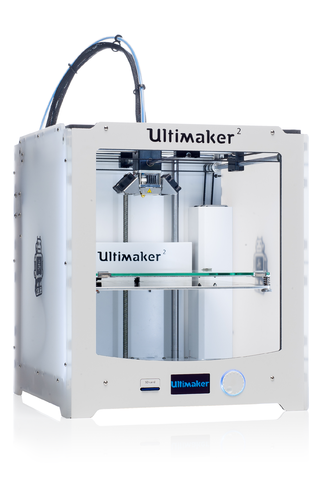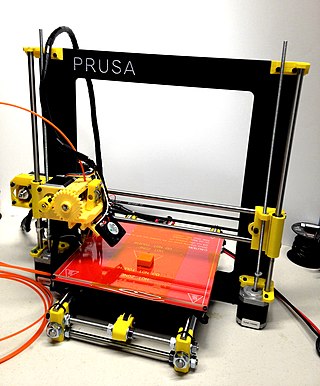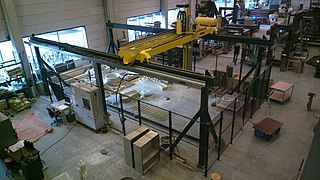Related Research Articles

Sintering or frittage is the process of compacting and forming a solid mass of material by pressure or heat without melting it to the point of liquefaction. Sintering happens as part of a manufacturing process used with metals, ceramics, plastics, and other materials. The nanoparticles in the sintered material diffuse across the boundaries of the particles, fusing the particles together and creating a solid piece.

Selective laser sintering (SLS) is an additive manufacturing (AM) technique that uses a laser as the power and heat source to sinter powdered material, aiming the laser automatically at points in space defined by a 3D model, binding the material together to create a solid structure. It is similar to selective laser melting; the two are instantiations of the same concept but differ in technical details. SLS is a relatively new technology that so far has mainly been used for rapid prototyping and for low-volume production of component parts. Production roles are expanding as the commercialization of AM technology improves.
Contour crafting is a building printing technology being researched by Behrokh Khoshnevis of the University of Southern California's Information Sciences Institute that uses a computer-controlled crane or gantry to build edifices rapidly and efficiently with substantially less manual labor. It was originally conceived as a method to construct molds for industrial parts. Khoshnevis decided to adapt the technology for rapid home construction as a way to rebuild after natural disasters, like the devastating earthquakes that have plagued his native Iran.

3D printing or additive manufacturing is the construction of a three-dimensional object from a CAD model or a digital 3D model. It can be done in a variety of processes in which material is deposited, joined or solidified under computer control, with the material being added together, typically layer by layer.
Laser powder forming, also known by the proprietary name is an additive manufacturing technology developed for fabricating metal parts directly from a computer-aided design (CAD) solid model by using a metal powder injected into a molten pool created by a focused, high-powered laser beam. This technique is also equivalent to several trademarked techniques that have the monikers direct metal deposition (DMD), and laser consolidation (LC). Compared to processes that use powder beds, such as selective laser melting (SLM) objects created with this technology can be substantially larger, even up to several feet long.

The NASA Institute for Advanced Concepts (NIAC) is a NASA program for development of far reaching, long term advanced concepts by "creating breakthroughs, radically better or entirely new aerospace concepts". The program operated under the name NASA Institute for Advanced Concepts from 1998 until 2007 (managed by the Universities Space Research Association on behalf of NASA), and was reestablished in 2011 under the name NASA Innovative Advanced Concepts and continues to the present. The NIAC program funds work on revolutionary aeronautics and space concepts that can dramatically impact how NASA develops and conducts its missions.

Rapid prototyping is a group of techniques used to quickly fabricate a scale model of a physical part or assembly using three-dimensional computer aided design (CAD) data. Construction of the part or assembly is usually done using 3D printing or "additive layer manufacturing" technology.
Digital modeling and fabrication is a design and production process that combines 3D modeling or computing-aided design (CAD) with additive and subtractive manufacturing. Additive manufacturing is also known as 3D printing, while subtractive manufacturing may also be referred to as machining, and many other technologies can be exploited to physically produce the designed objects.

Binder jet 3D printing, known variously as "Powder bed and inkjet" and "drop-on-powder" printing, is a rapid prototyping and additive manufacturing technology for making objects described by digital data such as a CAD file. Binder jetting is one of the seven categories of additive manufacturing processes according to ASTM and ISO.
Laser Rapid Manufacturing (LRM) is one of the advanced additive manufacturing processes that is capable of fabricating engineering components directly from a solid model.
Construction 3D Printing (c3Dp) or 3D construction Printing (3DCP) refers to various technologies that use 3D printing as a core method to fabricate buildings or construction components. Alternative terms for this process include "additive construction." "3D Concrete" refers to concrete extrusion technologies whereas Autonomous Robotic Construction System (ARCS), large-scale additive manufacturing (LSAM), or freeform construction (FC) refer to other sub-groups.

Fused filament fabrication (FFF), also known as fused deposition modeling, or filament freeform fabrication, is a 3D printing process that uses a continuous filament of a thermoplastic material. Filament is fed from a large spool through a moving, heated printer extruder head, and is deposited on the growing work. The print head is moved under computer control to define the printed shape. Usually the head moves in two dimensions to deposit one horizontal plane, or layer, at a time; the work or the print head is then moved vertically by a small amount to begin a new layer. The speed of the extruder head may also be controlled to stop and start deposition and form an interrupted plane without stringing or dribbling between sections. "Fused filament fabrication" was coined by the members of the RepRap project to give an acronym (FFF) that would be legally unconstrained in its use.
Digital manufacturing is an integrated approach to manufacturing that is centered around a computer system. The transition to digital manufacturing has become more popular with the rise in the quantity and quality of computer systems in manufacturing plants. As more automated tools have become used in manufacturing plants it has become necessary to model, simulate, and analyze all of the machines, tooling, and input materials in order to optimize the manufacturing process. Overall, digital manufacturing can be seen sharing the same goals as computer-integrated manufacturing (CIM), flexible manufacturing, lean manufacturing, and design for manufacturability (DFM). The main difference is that digital manufacturing was evolved for use in the computerized world.

In recent years, 3D printing has developed significantly and can now perform crucial roles in many applications, with the most common applications being manufacturing, medicine, architecture, custom art and design, and can vary from fully functional to purely aesthetic applications.

A variety of processes, equipment, and materials are used in the production of a three-dimensional object via additive manufacturing. 3D printing is also known as additive manufacturing, because the numerous available 3D printing process tend to be additive in nature, with a few key differences in the technologies and the materials used in this process.

Ian Gibson is a Professor of Design Engineering at the University of Twente. Gibson was selected as the scientific director of Fraunhofer Project Center at the University of Twente and is a recipient of lifetime achievement award, the Freeform and Additive Manufacturing Award. His main areas of research are in at the additive manufacturing, multi-material systems, micro-RP, Rapid Prototyping, Medical Modelling and tissue engineering.
Cold spray additive manufacturing (CSAM) is a particular application of cold spraying, able to fabricate freestanding parts or to build features on existing components. During the process, fine powder particles are accelerated in a high-velocity compressed gas stream, and upon the impact on a substrate or backing plate, deform and bond together creating a layer. Moving the nozzle over a substrate repeatedly, a deposit is building up layer-by-layer, to form a part or component. If an industrial robot or computer controlled manipulator controls the spray gun movements, complex shapes can be created. To achieve 3D shape, there are two different approaches. First to fix the substrate and move the cold spray gun/nozzle using a robotic arm, the second one is to move the substrate with a robotic arm, and keep the spray-gun nozzle fixed. There is also a possibility to combine these two approaches either using two robotic arms or other manipulators. The process always requires a substrate and uses only powder as raw material.

Behnaz Farahi is an Iranian-born American interdisciplinary designer and educator whose work melds architecture, fashion, interaction design, computational design, wearable technology and the human body. Her designs often explore the possibilities of human interaction with the environment and how technology can facilitate this interplay. Her work engages with the human body's relationship to its surroundings and how wearable technology can respond to, or be influenced by stimuli such as human emotions or environmental factors. Leveraging technology and art, Farahi's works are commentaries on power dynamics, society, and identity, frequently drawing inspiration from her cultural background and Western theories and practices, underpinned by theoretical concepts including socio-political feminist theory and anthropology.

3D food printing is the process of manufacturing food products using a variety of additive manufacturing techniques. Most commonly, food grade syringes hold the printing material, which is then deposited through a food grade nozzle layer by layer. The most advanced 3D food printers have pre-loaded recipes on board and also allow the user to remotely design their food on their computers, phones or some IoT device. The food can be customized in shape, color, texture, flavor or nutrition, which makes it very useful in various fields such as space exploration and healthcare.

3D concrete printing, or simply concrete printing, refers to digital fabrication processes for cementitious materials based on one of several different 3D printing technologies. 3D printed concrete eliminates the need for formwork, reducing material waste and allowing for greater geometric freedom in complex structures. With recent developments in mix design and 3D printing technology over the last decade, 3D concrete printing has grown exponentially since its emergence in the 1990s. Architectural and structural applications of 3D-printed concrete include the production of building blocks, building modules, street furniture, pedestrian bridges, and low-rise residential structures.
References
- ↑ "Lunar Settlement: Piecing Together a Full Moon Picture".
- ↑ - Behrokh Khoshnevis
- ↑ "- Contour Crafting". Archived from the original on April 22, 2012. Retrieved October 27, 2014.
- ↑ "- SIS". Archived from the original on October 27, 2014. Retrieved October 27, 2014.
- 1 2 Wertheim, Margaret (March 11, 2004). "Robots That Build (but Still Won't Do Windows)". The New York Times.
- 1 2 "Houses built by robot? If scientist gets his way" (PDF). Archived from the original (PDF) on March 26, 2014. Retrieved October 28, 2014.
- 1 2 "Häuser aus dem Drucker". Der Spiegel. January 21, 2007.
- ↑ "Robot builder could 'print' houses" (PDF). Archived from the original (PDF) on March 26, 2014. Retrieved October 28, 2014.
- ↑ USC – Viterbi School of Engineering – Behrokh Khoshnevis
- ↑ Doctoral Advisees | Dr. Behrokh Khoshnevis | Behrokh Khoshnevis is a professor of Industrial & Systems Engineering and Civil & Environmental Engineering, and is the Director o...
- ↑ Khoshnevis, Behrokh (2004). "Automated construction by contour crafting—related robotics and information technologies". Automation in Construction. 13 (1): 5–19. CiteSeerX 10.1.1.652.3193 . doi:10.1016/j.autcon.2003.08.012.
- ↑ U.S. Patent WO2001038061A (“Process of making a three-dimensional object”)
- ↑ U.S. Patent EP1534461B1 (“Metallic parts fabrication using selective inhibition of sintering (sis)”)
- ↑ "Computerized 3D Construction Method Wins Global Design Contest".
- ↑ "NASA Tech Briefs 2014 Winners".
- ↑ "Robotic Construction by Contour Crafting" (PDF).
- ↑ Blumenthal, Amy (April 4, 2016). "New 3D printing process could lead to construction on Mars and the moon". USC News. University of Southern California . Retrieved September 2, 2023.
- ↑ "Contour Crafting: Automated Construction: Behrokh Khoshnevis at TEDxOjai". YouTube . Archived from the original on December 21, 2021.